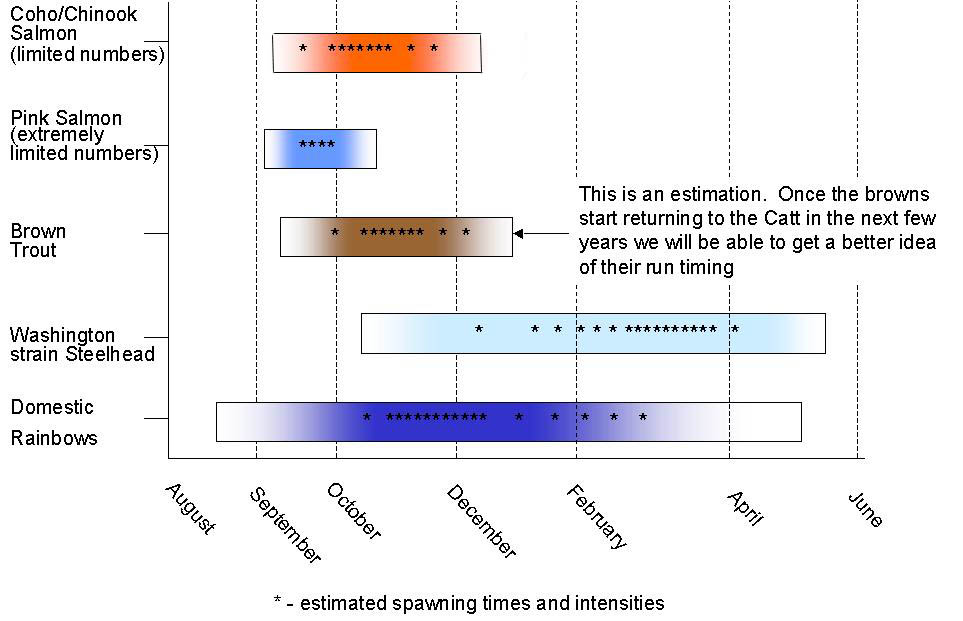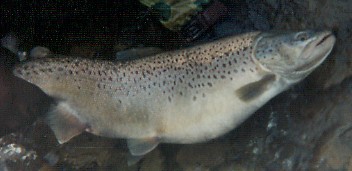
The Fish
Click here to see ways to determine wild vs. hatchery steelhead

This chart shows the timing of salmonid presence in Cattaraugus and its tributaries. Keep in mind these are approximations and can vary from year to year based on lake and stream temperatures, stream discharge, etc.
Steelhead (Oncorhynchus mykiss)
1) Steelhead new born approx.
one month old trapped in early June 2) One-year-old steelhead approx.
4 in. long trapped in May 3) Two-year-old steelhead smolt approx.
6 in. long trapped in May 4) Adult steelhead approx. 24 in. long.
Steelhead (Oncorhynchus mykiss) are anadromous rainbow trout that are native to the Pacific coast. They are born in fresh water streams and remain there for up to three years as parr. Steelhead parr will eventually develop the urge to emigrate out of their nursery streams. During this time, they lose their oval parr markings and coloration, turn silvery, and begin to move downstream towards the ocean. This is termed smoltification. They mature in the ocean and then return to spawn in the tributaries they were born in.
New York’s steelhead are raised at the Salmon River Hatchery in Altmar, New York. The steelhead’s gametes are obtained from fin - clipped, feral Lake Ontario broodstock which return to the hatchery via the Salmon River (Eckert and Schneider, 1996). These steelhead originated from Chambers Creek (Washington state) strain eggs received from the west coast. In the spring, they are stocked into Lake Ontario and Erie tributaries just prior to smoltification to allow them to imprint to that particular stream at 1+ years of age.
Skamania steelhead were also stocked in Cattaraugus Cr. and other Lake Erie tributaries in the late 80's and mid 90's. These are a summer run strain which shows up in streams during the summer months and spawns in the early spring. Due to low water conditions during the summer and extremely warm water in the Cattaraugus during the summer, skamanias were never very successful. They probably don't exist in Erie any more as the past stockings would have died out of the lake population by now.
Up until 2001, there were also domestic rainbow trout stocked in the near shore areas of Lake Erie. Since there is probably no suitable spawning conditions in the lake, they are thought to ascend our area streams in the fall to spawn. The domestic rainbow trout stocked into Lake Erie are raised at the state hatchery in Randolph, NY. The broodstock are maintained at the hatchery and are spawned in the fall. The broodstock is thought to have originated from a Wytheville strain, which came from Montana (Arndt et al. 1991). Fall spawning of domestic rainbow trout is accomplished by artificially changing the photo period to produce a gravid fish for a fall egg take. This results in a larger rainbow to stock in the second spring of their life, compared to an equivalent aged rainbow spawned in the spring.
Steelhead
and domestic rainbow trout are the same species (O. mykiss)
but different strains. There are phenotypic differences between the two
strains in the adult stage. Steelhead are sleeker in shape with a
blue green hue to their coloration. Domestic rainbows are generally
more colorful (Cornelius, NYSDEC, pers. comm.) with pronounced red cheeks
and stripe. It is thought that domestic rainbow trout spawn earlier than
steelhead, ascending streams in the fall and spawning in late fall and
winter (possibly a result of the fall breeding of the parental broodstock
in the hatchery (Cornelius, NYSDEC, pers. comm.)). Steelhead are
generally spring spawners.

1) Domestic rainbow trout at the
state hatchery in Randolph, NY 2) This is most likely a domestic
rainbow trout (approx. 26 in.), since it was found spawning in mid
November.
Since the termination of coho salmon stocking by New York in 1992, approximately 250,000 steelhead are planted each year in Lake Erie. Cattaraugus Creek receives about 90,000 of this lot with the rest spread out among the other main New York tributaries and Dunkirk Harbor. In 2002, domestic rainbow stocking was discontinued due to problems with whirling disease at the Randolph Hatchery and an attempt to reduce the possibility of interbreeding between steelhead and domestics. Brown trout (Salmo trutta) will be reintroduced to make up for the loss.
**Click
here to see current and past salmonid stocking levels**
Brown Trout (Salmo trutta)

Brown
trout were stocked by NY from 1974 to 1993. Due to limited numbers
of adults returning to the creel (Culligan et al. 1998) they were discontinued
in 1994. Brown trout stocking began again in the spring of 2002 in
order to replace domestic rainbow trout. This is an attempt to reduce
possible interbreeding between steelhead and domestics (Markham, 2002 unpublished
data). Hopefully with the now extremely abundant round gobies in
Lake Erie, large predators such as bass will turn their attention towards
the gobies and away from the stocked brown trout thus increasing brown
trout survival until they can move offshore.
Chinook Salmon (Oncorhynchus tshawytsha)
1 & 2) Juvenile chinook salmon
approx. 1 to 2 in. long 3) Adult chinook salmon
Most strains of juvenile chinook salmon (Oncorhynchus tshawytsha) spend only a few months in streams (whether they are stocked or wild) before smolting and moving to the lakes. They will then spend three to four years in the lakes before returning to the streams to spawn, but some streams will have runs of 2 year old "jack" salmon, which are immature males.
New
York began its chinook stocking program in 1973 (Culligan, 2001). This
program was marginally successful with few adults contributing to angler
creels. During the 1980's and early 90's, New York stocked approximately
500,000 chinooks per year with most of these planted in Cattaraugus Cr.
In 1997, New York stocked its last lot of chinook salmon due to poor adult
returns. Due to Lake Erie not being suitable for chinook salmon,
the other states surrounding Erie and Ontario had already eliminated their
chinook stocking programs. Although there has been no documentation
of wild chinook salmon in the Cattaraugus Creek watershed, there
have still been very limited numbers of adults returning to the Cattaraugus
recently. This has occurred past the time when the last group of
hatchery fish would have returned to the system. This leads to the
conclusion that there is very limited reproduction of chinook salmon in
the good gravel areas of the Cattaraugus Cr. or there is straying from
other wild stocks along the lake. There is no plans in the future
to reestablish a chinook fishery in NY's portion of Lake Erie, but there
will probably always be a few present as a result of natural reproduction.
Coho Salmon (Oncorhynchus kisutch)
1) Coho salmon juvenile < 1
yr. old caught in December 2) One year old coho smolt approx. 5 in.
long trapped in May 3) Adult coho salmon
Coho salmon (Oncorhynchus kisutch) have a little different life history than chinooks. They have an extended stream residency after birth similar to steelhead. They will usually smolt at 14 to 16 months of age and then spend approximately two years maturing in the ocean. Due to this, they need suitable habitat to rear through the first summer of their lives in streams.
Coho salmon were stocked by New York up until 1992. Again, coho salmon made little contribution to fishermen's creel compared to rainbow/steelhead. Pennsylvania is the only state that is currently stocking coho salmon into Lake Erie. There has also been documented catches of naturally produced coho salmon juveniles in tributaries of Cattaraugus Creek. So, there will probably always be some coho salmon found each fall in the Catt and other Lake Erie tributaries through natural reproduction and straying from PA stocks.
Pink Salmon (Oncorhynchus gorbuscha)
1) Newly hatched pink salmon heading
towards the ocean 2) Adult pink salmon
Pink salmon are the smallest of the pacific salmon. Like the other salmon species, pink salmon are born in freshwater streams but emigrate to the ocean as soon as they emerge from the gravel. They spend two years in the ocean before coming back to the streams to spawn. Their spawning runs are known to be extremely short, migrating just a couple miles upstream into their natal streams.
In 1956,
pink salmon were introduced (some say accidentally) by a single planting
of 20,000 fingerlings in the Current River, a tributary of Thunder Bay,
Lake Superior. From this single planting, pink salmon spread throughout
the Great Lakes. In the fall of 1969, they were found throughout
most of Lake Superior and had spread into Lake Huron (Parsons, 1973).
Today, pink salmon can be found in all the Great Lakes. Because they
maintain a strict two year life cycle, their spawning runs occur in odd
or even numbered years in most tributaries. In New York's section
of Lake Erie, limited numbers of adults are seen on even numbered years
usually in the Cattaraugus. All pink salmon in the Great Lakes are
maintained through natural reproduction.
Culligan, W. J., F. C. Cornelius, D. W. Einhouse, D. L. Zeller, R. C. Zimar, B. Beckwith, and M. Wilkinson. 1998. Annual report to the Lake Erie Committee. New York State Department of Environmental Conservation, Albany, 28 pp.
Culligan, W. J., J L. Markham, D. W. Einhouse, D. L. Zeller, R. C. Zimar, B. Beckwith, and M. Wilkinson. 2002. Annual report to the Lake Erie Committee. New York State Department of Environmental Conservation, Albany, 70 pp.
Eckert, T. H. and C. P. Schneider. 1996. Lake Ontario stocking and marking program 1996. pp. 1-8, In 1996 Annual Report to the Lake Ontario Committee. New York State Department of Environmental Conservation, Albany.
Markham, J. L. 2002. Summary
of the 2001 Lake Erie Angler Diary Program. Unpublished data. 14
pp.